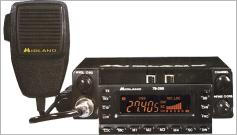In This Issue
Review Of The Midland 79-290
The Midland 79-290 is the smallest sideband mobile available today. It
measures only 2" high by 6.25" wide by 7" deep. The small size combined
with the detachable face makes it possible to safely mount it permanently in
many vehicles.
This is a new generation of CB radio designed and manufactured in Korea.
Instead of producing a convertible 10 Meter amateur they have used the
reverse philosophy. Producing a convertible FCC approved CB. Maybe the
industry is trying to keep ahead of Uncle Charlie. It could just be a matter of
time before Uncle Charlie wakes up and realizes that the 10 Meter loophole
is being stretched beyond its limits with the Connex, SuperStar and Galaxy type 10 Meter only units. It's
obvious that they are DX radios with their band switches disabled.
The Midland has some unique features for a legal SSB CB unit. It has dual watch capability. This option gives
the operator the ability to select and monitor a second channel during normal operations. Also four
programmable memory channels can be selected at a push of a button or scanned for activity if desired. The
LCR button stands for last channel recall and returns the unit to the previous channel when depressed. This
allows quick jumping between two channels. In addition a fine and coarse clarifier are provided for easy tuning
while on the move.
Opening the unit and at a quick glance you realize that this isn't a copy of an earlier product. The only similarity
between this radio and any other unit is in the transmitter final output. The final output stage uses two 2SC1969
transistors instead of the traditional single transistor. This is the same configuration used in the export and most
10 meter radios that have 30 - 40 watt PEP output. The only difference is they employ the 2SC2312 transistors
in the final stage. Three variable resistors are used to adjust the AM and SSB output of the transmitter. VR8 is
the SSB ALC control, VR3 is the AM power adjustment and there is a VR for adjusting the AM modulation.
What's missing is the driver and final bias adjustments. I find that these adjustments are important in getting
the cleanest signal on sideband. But I know that most factories don't do a fine adjustment on these controls
anyway.
This Midland unit tuned up to 28 watts PEP and 8 watt dead key swinging up to 25 watts on AM. The audio on
sideband had a slight warble that I was unable to correct with the normal schemes I've used in the past. The
audio was clean on AM and when the sideband output was reduced to 12 watts PEP. The stock mic supplied is
adequate but nothing special. A good quality mic would improve the tone quality but wouldn't improve the
warble. A warble is usually caused by poor voltage regulation at the PLL/VCO or in the clarifier circuit. As the
output was turned up I notice the display lamps dimmed excessively possibly indicating a poor path for the 13.8
voltage supply. This could be the reason for the warbling transmission.
Frequency modifications are enabled by changing solder shorts on the PC board in the detachable face and
are user selectable by way of the front panel. The five digit frequency display comes in handy once the
expansion is made. No road map needed here. Once the deed is done there are three options to choose from.
The normal default is strait forty channels. The second option is expanded coverage of 240 channels from
25.615 MHz to 28.305 MHz. And the third option is 10 Meter coverage from 28.000 MHz to 29.700 MHz by 10
KHz steps totaling 170 channels.
To switch from 40 to 240 channels depress both the "DW"' and "9" buttons simultaneously while turning the
power on. At first a "D" symbol will appear on the LCD display. Bands "A"' through "F" can be selected by
depressing the "19" button. To return to the regular 40 channel mode just repeat the steps above.
To switch from 40 channels to 10 Meter coverage depress both the "LCR" and "Mic" buttons simultaneously
while turning the power on. 28.000 MHz will be displayed on the LCD display. As before to return to 40
channels repeat the steps above.
It's not possible to switch directly from 240 channel mode to the 10 Meter mode or visa versa. The expanded
modes can only be accessed from the 40 channel mode. This front panel selection of expansion is great if you
don't want Uncle Charlie to catch you with extras or unauthorized out of band or ham band use.
Memory back-up is achieved with a rechargeable battery in the detachable face of the unit. Power must be
applied to the radio for 120 hours to fully charge the battery. A fully charged battery will hold the memory for
240 hours. Also the face or control head must be removed from the radio to achieve 240 hour memory back-
up. If memory power is lost the radio returns to the default 40 channel mode.
The S meter looked flashy but after close inspection I realized the segments jumped by two for readings above
S9. I don't understand why they provided all the bars in the meter if they weren't going to make proper use of
them. 'Me meter reacted the same in the RF mode too.
Unfortunately the receiver was the biggest disappointment in the radio. When attached to a base antenna I was
almost unable to determine what channel some operators were on because they were bleeding over all forty
channels. I could understand every word. The only way I could tell the channel they were on was when their
audio sounded clear. I've never encountered this level of splatter in any radio before. When checking the
offending signals with a Tram D201 I found their signals to be between 10 to 20 dB and they were hardly
noticeable on the adjacent channels. I also did some research and found that I wasn't the first to experience
this problem with the 79-290.
Although the problem would be less severe in mobile operation, it would still be difficult to communicate with
the low level signals splashing the receiver. It would be frustrating on interstate highways or in areas heavily
populated with CBers. I've heard stories of drivers throwing radios out the window for less.
In summary I must say I'm impressed with the features and size of the radio. It has real potential to be a big
player in the CB market. For that to happen they need to address some problems. I think the battery life is
inadequate. Six days of back-up isn't really enough, especially when the battery charge rate is so slow. It takes
3 days of uninterrupted 12 volt supply to the radio to fully charge the battery. Second all the segments of the
meter display should be driven separately for proper resolution. Third the sideband warble must be resolved.
Finally the receiver must be improved or redesigned, the radio isn't useable in its present condition. One other
feature that I'd like to see is 5 KHz steps in the expanded modes. I hope Midland bites the bullet and corrects
the problems, I know I could sell many of these radios. Especially if the HR2510s are really history. ©
CBWI


© CB World Informer Network 1996 - 2023 Worldwide Rights Reserved



AUGUST
VOLUME 1
ISSUE 5


- August 1996
- September 1996
- October 1996
- November 1996
- December 1996
- Review Of Midland 79-290 AM/SSB Mobile
- Cobra/Uniden SSB Chassis Mod UPDATE
- Clarifiers
- President Jackson Unlocked Clarifier Mod.
- Cobra 148 & Uniden GrantXL Clarifier Mod.
- Cobra 142GTL & Uniden Washington Clarifier
- Uniden Grant Unlocked Clarifier Mod.
- Uniden PCI22 PRO SSB Clarifier Mod.
- Review Of The Northstar DX880HL
- Big Bust At The Consumer Electronics Show
- Bob's CB Has Opened
- January 1997
- The New Mongoose Model 450 Review
- Wilson Antenna Tests The Trucker 5000
- A Company With Interference Solutions
- Solving Telephone RF Interference
- Lowpass Filters: What, Where, And How
- Using Highpass Filters For TVI
- How To Conduct A Noise Audit
- Modern Do-It-Yourself Grounding Techniques
- Using Water Pipes For RF Grounding
- Using Water Pipes For RF Grounding
- February 1997
- The New Emperor TS-3010 Review
- Bulkhead Grounding
- Grounding Coaxial Cable Shields
- Using Anti-Oxidants
- Modern Lightning Protection - RF Entry Ports
- Modern Lightning Protection - AC Power Lines
- Modern Lightning Protection - Control Lines
- Modern Lightning Arrestors - Polyphaser VS I.C.E.
- Modern Lightning Arrestors - Alpha Delta VS I.C.E.
- Modern Lightning Arrestors - Cushcraft VS I.C.E.


- July 2001
- Galaxy DX 2547 Reveiw
- Inside The DX 2547
- DX 2547 Channel Mod
- DX 2547 Clarifier Mod
- DX 2547 Photos
- DX 2547 Manual Excerpts
- The Anttron Story
- Anttron 305 Revisited
- New Antrron Products
- Aries A-SWR 460 Digital Meter
- Barjan Buys Wilson Antenna
- Wilson Electronic In Cell Phone Market
- First Web Issue
- Help Get The Word Out
- August 2001
- Sneak Preview: The New Maverick A24
- Maverick A24 Front Panel Controls
- Maverick Conversion
- Inside The Magnum Maverick A24
- Barjan Buys Francis Antenna
- Wilson Antenna, 1 Year After Barjan Buyout
- CBer Busted
- Astaic's MobileMax
- Solarcon I-Max 2000
- False Performance Claims
- CAUTION: Don't Burn Out That Radio
- Magnum's Filtered Power Cord
- Dragon Super Heavy Duty SO-239 Stud
- CBWI...Give Us Your Opinion
- September 2001
- Reveiw Of The RCI 2950DX
- RCI 2950DX Image Rejection Modification
- RCI 2950DX Coversion & Clarifier Mods
- RCI 2950DX Photos
- RCI 2950DX Board Component Layout
- RCI 2950DX Adjustment Layout
- RM-9807: Petition To Remove 155 Mile Limit
- Slip-Seat Radio Box
- RF Limited UTB-1 Adjustable Talkback Board
- A Message From The Editor
- October 2001
- November 2001
- December 2001
- January 2002
- February 2002
- July 2002
- June 2014

































